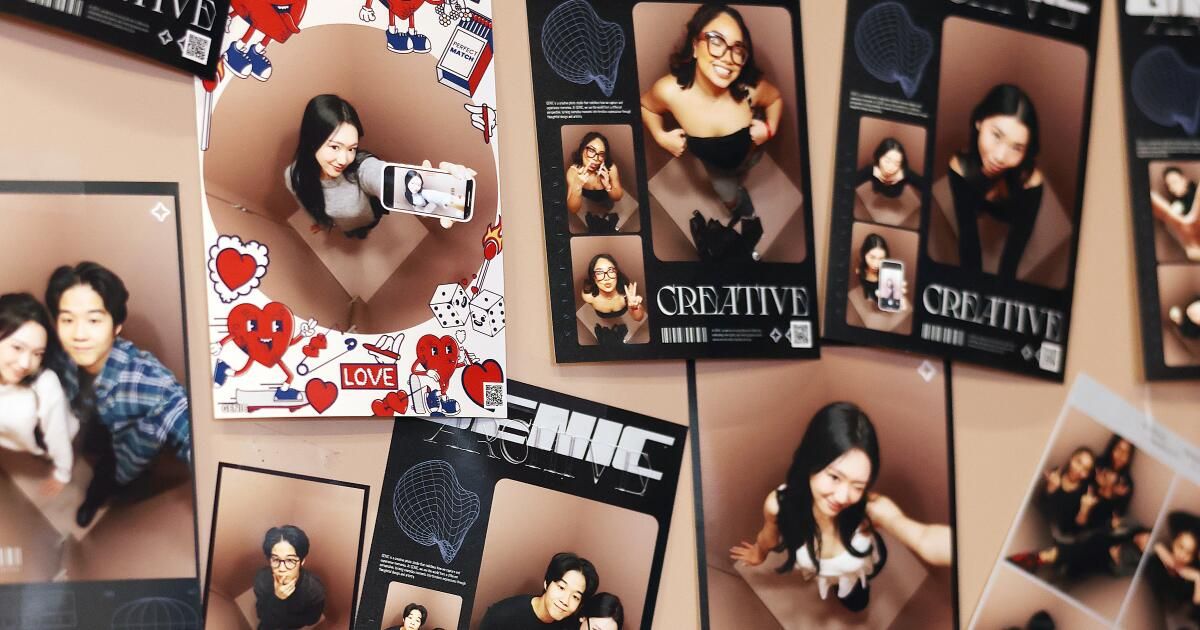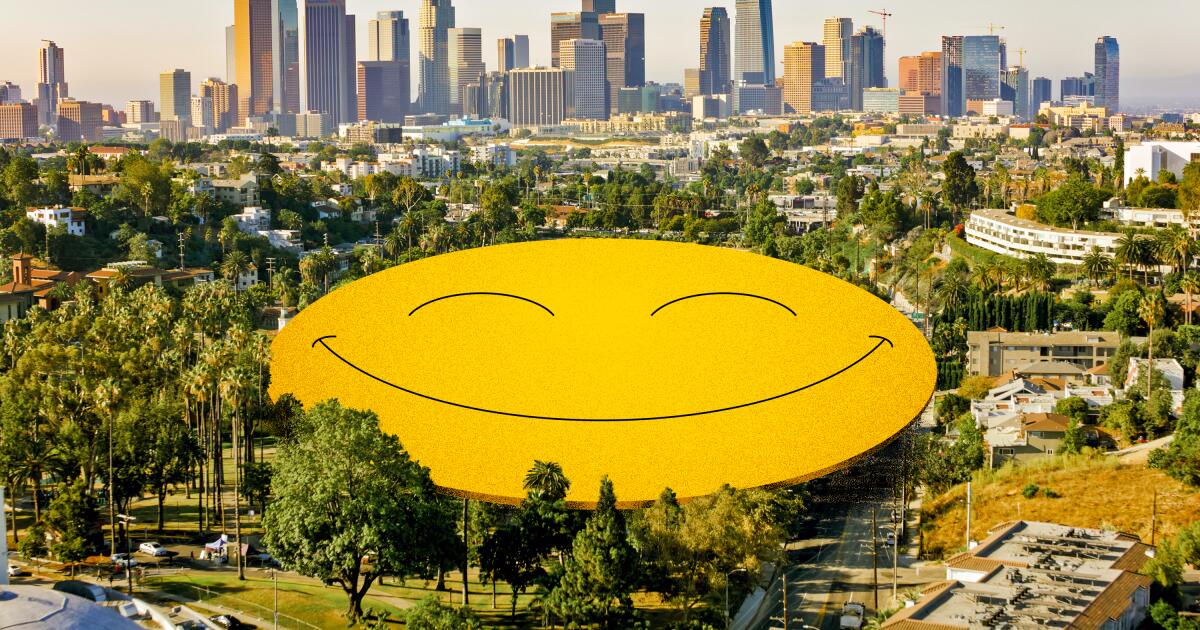In a recent Saturday afternoon in the district of the Arts, a group of seven friends, plus a small dog, twisted and twisted their bodies to fit inside a light brown box of 8 feet high that had a reflected door inscribed with the words “Memory Archive”.
Once they were all mostly Inside, they looked towards a DSLR Canon camera that appeared from a small hole. They posed, smiling brilliantly, forming their fingers in peace signs and heart shapes, and holding the dog in the air like the baby Simba, while the shutter click eight times. Then they left the cabin, selected their favorite shots in a kiosk and waited about 60 seconds to develop the photos.

The photos take about 60 seconds to develop.
(Christina House / Los Angeles Times)
The energetic group of new friends, most of whom had only met a few hours before in a Rave, had run into the photomaton while grabbed food in Idyllic Cafe and decided to commemorate the moment. The results sprouted.
“This was very nice,” says Eugenia Bulah, 41.
During the rest of the afternoon, dozens of other elegant people in the bustling coffee rose with their friends and other important people in the genic photomaton, a “high angle” cabin that takes images from a high perspective.
The founders of Genic MJ and Ryan Kim, two recent graduates of the UCLA that are not related, said that since they installed the stand in Idyllic Cafe at the end of February, it has captured almost 1,000 photos. The duo has two other high angle booths in Los Angeles, one in a cafe called Time in Koreatown and another in the food court of the city of Westfield Culver, as well as a regular selfie style cabin in my coffee in Koreatown.

Ryan Kim, on the left, and MJ Kim are photographed in his generic photomaton pop-up in Idyllic Cafe.
(Christina House / Los Angeles Times)
Invented by Anatol Josepho, the first photomaton made his debut in New York City in 1925. A century later, there is no shortage of photomatons in Los Angeles that can be found in bars, elegant hall lobbies, coffee shops, shopping centers and other businesses. But in recent years, these original selfie machines, like vinyl records and the use of disposable cameras, have experienced resurgence, particularly among younger generations. Rather, he only has many images on his phone, photography boat lovers appreciate the physical memory they can place in their refrigerator, in an album of cuts or in frames around their home.
Technology has triggered granulated images of low resolution in a photo strip. People can now take photos from a high angle (which some find more flattering), use extravagant accessories, select between history and limited editing frames or pose with their favorite K-pop artist. Other popular photomatones companies, with locations in Los Angeles and in all of the United States, include Potobox, Life 4 cuts and Photoism.
“It has always been one thing, but lately it has become absolutely crazy because all young people got into that and are putting videos on Instagram and Tiktok,” says Mike Rybak, 58, who has been an analog photomaton technician for more than 20 years. Your company, Photographic illusionHe has installed 40 cabins in Los Angeles, including the most popular in 4100 bar, which averages 2,000 photos per month.
Rybak also supplied the famous photographer and creator of Bryant Eslava content, the vintage vintage machine known as Bryant Booth, which has been adorned by celebrities such as Kardashians, Jaden Smith, Lil Wayne, Martha Stewart, the cast of “Succession” and more. (There is a Bryant Machine stand in Los Angeles on Harriet's roof in West Hollywood and two others at Costa Mesa).
“I think the ascending trend occurred just after Covid,” adds Rybak. “People were locked up and nobody could go to the bars, and as soon as everything reopened, people went crazy.”

Madison Aubry, on the left, and Trron Edwards select his photos of the genic photomaton.
(Christina House / Los Angeles Times)

Ryan Kim demonstrates how to use the photomaton that he and MJ Kim created.
(Christina House / Los Angeles Times)
This renewed emotion that surrounds photomatons is part of the reason why Gen Zers and the friends of the MJ Kim and Ryan Kim University launched their company, Genic (abbreviation for “photogenic”), in April 2024.
“I love taking photos. This is how it started,” says MJ, 23, who specialized in data and statistics. She is the unofficial face of the brand and many of her photos are glued to the side of the Genic stand to get inspiration. “I just felt something different [whenever] I took photos with my friends in the photomatons, “adds MJ.” There were many laughs and we always became so creative with the poses. “She and Ryan thought that having a photomaton in or near the UCLA campus could raise their experience.
At first, MJ and Ryan had trouble finding a manufacturer that allowed them to buy a single cabin instead of multiple, which is all they could pay at that time. But after months of hunting, they found one based in South Korea, where they are both, who believed in their vision and sold them a single cabin for around $ 20,000. They used their savings to pay it, then they started trying the stand in Ryan's three bedroom apartment, which he shared with roommates.

Ryan Kim, on the right, and MJ Kim.
(Christina House / Los Angeles Times)
Inspired by the popularity of photomatons in South Korea, where cabins can be found in almost every corner of the The most busy district of the city, Hongdae – MJ and Ryan wanted to create a cabin that would take photos above, to inspire people to “always dream and look up.”
“The photomatons are so great in South Korea,” says Ryan, who specialized in design in UCLA. “It is really a culture. It is a lifestyle for people. But we did not want to simply bring that industry to the United States because the brand is a bit different and we really wanted to resonate with the entire US market instead of only Asian Americans in the United States, so we tried different brands. Something that is a little cooler.” With Genic, they wanted to establish a creative and recognizable lifestyle brand, Ryan adds.
Once the duo nailed the mechanics and design for its first photomaton, which had a regular angle instead of a high one, they began asking companies near their university if they could install it there, for free. Finally, Melo Melo, a coconut dessert store in Sawtelle, gave them green light and offered them an emerging three -month residence, starting last April.
Catherine Thomas, an advantage in Melo Melo, says they agreed to work with Genic because they wanted to collaborate with the students and thought that the stand would attract their university crowd.
“It was really successful,” says Thomas, and adds that weekend nights were the busiest. “It definitely also helped with our sales, attracting new people.”
Shortly after the Melo Melo residence ended, the duo moved the cabin to Coffee Mco in Koreatown for a two -week emerging window. They used the money from their sales to buy three high -angle photomatons. MJ and Ryan, who run full -time genic, say they hope to buy more positions and expand to more locations in Los Angeles and beyond. They also hope to collaborate with brands and events, and eventually open a flagship store.
MJ and Ryan designed their stand to feel like an experience and, as if you were filming for the cover of a magazine. First, you will select what type of frame you want in the kiosk machine, the original, which looks like a traditional photo strip and costs $ 10 for two impressions; Or the most popular, the firm's frame, which mimics a fashion editorial with a large image or three photos and costs $ 12 for two impressions. The photos also have a QR code at the bottom, so you can download high quality digital versions of your photos, as well as a live video of you experiencing the cabin.

The friends Stacy Salazar, on the left, and Cassandra Leviste show their photos of photomatons.
(Christina House / Los Angeles Times)
Back in Idyllic, MJ and Ryan, who visit their photomatons daily to make sure they are working properly, observed while people entered and left the machine. Among the crowd were friends Cassandra Leviste, 22, and Stacy Salazar, 20, who visited coffee specifically to see the genic cabin, which they said had been appearing on their page “For you” in Tiktok for weeks.
“It is not really a common angle for a photomaton, so before we [came]We were looking at photos of inos on Pinterest, “says Leviste, 22, who lives in the Valley.” We were seriously. “They agreed their positions in advance and coordinated their outfits.
Leviste says that he loves photomatons because they are a convenient way to capture physical memories with their loved ones without having to ask another person to take a photo.
“I have been in so many photomatons that I am running out of space on my bulletin board,” he says, laughing.












